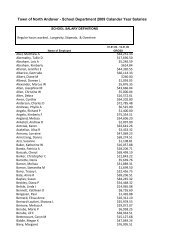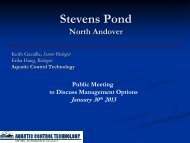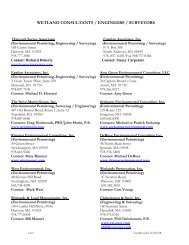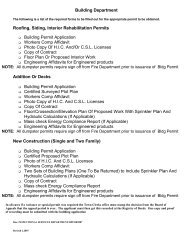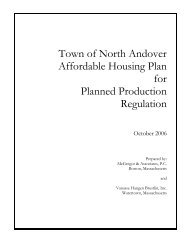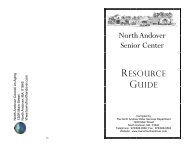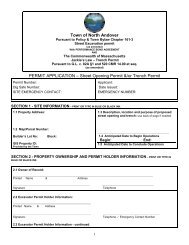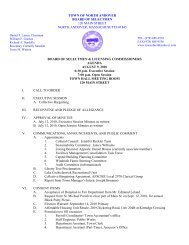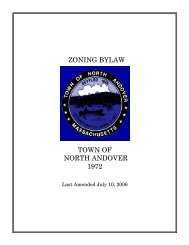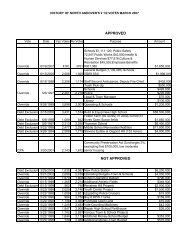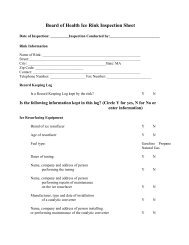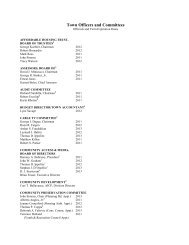Open Space and Recreation Plan - Town of North Andover
Open Space and Recreation Plan - Town of North Andover
Open Space and Recreation Plan - Town of North Andover
Create successful ePaper yourself
Turn your PDF publications into a flip-book with our unique Google optimized e-Paper software.
T O W N O F N O R T H A N D O V E R<br />
O P E N S P A C E A N D R E C R E A T I O N P L A N 2 0 0 6<br />
Forest Resources<br />
2 0 1 0 U P D A T E<br />
<strong>North</strong> <strong>Andover</strong>'s percent <strong>of</strong> forested l<strong>and</strong> apparently has not changed much in the last 40 years. Table 3.42<br />
indicated that in 1951, 53% <strong>of</strong> <strong>North</strong> <strong>Andover</strong> was forested while 48% was forested in 1985. This statistic is<br />
misleading since many residential subdivisions in a forested l<strong>and</strong>scape will be classified as forest in aerial<br />
photograph interpretation. When one reviews aerial photos <strong>and</strong> road maps, a better underst<strong>and</strong>ing <strong>of</strong> <strong>North</strong><br />
<strong>Andover</strong>'s forests can be gained. There are relatively few areas <strong>of</strong> unbroken forest remaining. These remaining<br />
forests include l<strong>and</strong>s that are unbuildable such as swamps <strong>and</strong> protected open space.<br />
<strong>North</strong> <strong>Andover</strong>'s forests are typical for the southern New Engl<strong>and</strong> region. The younger forests, those taking<br />
root after clearing, are characterized by the presence <strong>of</strong> gray birch (Betula populifolia), poplars (Populus sp.) <strong>and</strong><br />
(particularly in the wet areas) red maple (Acer rubrum). Post-agricultural forest may include black cherry (Prunus<br />
serotina), white ash (Fraxinus alba), locust (Robinia pseudo-acacia), red maple (Acer rubrum) <strong>and</strong> apple (Pyrus spp.).<br />
The more mature upl<strong>and</strong> forests are dominated by red oak (Quercus rubra), hickories (Carya sp.), white pine<br />
(Pinus strobus), <strong>and</strong> a wide variety <strong>of</strong> hardwoods. Red maple dominates the majority <strong>of</strong> forested wetl<strong>and</strong>s. A<br />
large Atlantic White Cedar Swamp encompasses Cedar Pond in the southeastern part <strong>of</strong> <strong>North</strong> <strong>Andover</strong> <strong>and</strong><br />
southwestern portion <strong>of</strong> Boxford State Forest. This is ideal habitat for the Hessel’s Hairstreak butterfly<br />
(Callophrys hesseli), species <strong>of</strong> special concern. These may be the remnants <strong>of</strong> the cedar swamps that were an<br />
important resource for the earliest settlers. "Sawing wood for shingles was a pr<strong>of</strong>itable business, <strong>and</strong> there was<br />
such a dem<strong>and</strong> for them in the town that the inhabitants were forbidden to sell them out <strong>of</strong> town without<br />
special permission" (Bailey, 1880). Only a few cedar swamps exist in Massachusetts, most being logged for<br />
shipbuilding <strong>and</strong> shingles many years ago.<br />
No st<strong>and</strong>s <strong>of</strong> old growth forests exist in <strong>North</strong> <strong>Andover</strong>. Approximately 0.05% <strong>of</strong> Massachusetts has been<br />
identified as old growth. This is a result <strong>of</strong> extensive agricultural l<strong>and</strong> use over the last 200 years. There are<br />
some individual specimens that are quite old, particularly 'boundary oaks' <strong>and</strong> street trees, such as white oak,<br />
various red oaks, sugar maples, beech, white pine <strong>and</strong> others. Such specimens should be sought out <strong>and</strong><br />
preserved to remind us <strong>of</strong> what the primeval forest held when the l<strong>and</strong> was first settled.<br />
The Massachusetts Natural Heritage & Endangered Species Program (NHESP) has identified six (6) state-listed<br />
plant species in <strong>North</strong> <strong>Andover</strong>. Only one plant, the purple needlegrass (Aristida purpurascens) a threaten species<br />
was recently observed in 2000. Other species identified by the NHESP include reed bentgrass (Calamagrostis<br />
pickeringii) an endangered species, cat-tail sedge Carex typhina) a threatened species, broom crowberry (Corema<br />
conradii) <strong>of</strong> special concern, <strong>and</strong>rews’ bottle gentian (Gentiana <strong>and</strong>rewsii) an endangered species, <strong>and</strong> New<br />
Engl<strong>and</strong> blazing star (Liastris scarisoa var. novae-angliae) <strong>of</strong> special concern. This, <strong>and</strong> possibly other, rare /<br />
threatened / endangered species will be sought out <strong>and</strong> protected whenever possible.<br />
Only four (4) l<strong>and</strong>owners protect 59.52 acres <strong>of</strong> forested l<strong>and</strong> through Chapter 61, the Massachusetts Forest<br />
Tax Law tax. Approximately 18 more acres have been protected under Chapter 61 since the 2000 <strong>Open</strong> <strong>Space</strong><br />
& <strong>Recreation</strong> <strong>Plan</strong>. This method <strong>of</strong> temporary l<strong>and</strong> preservation has been successful at least in the short term<br />
since no l<strong>and</strong> classified as forestl<strong>and</strong> has been developed since the 1995 <strong>Open</strong> <strong>Space</strong> <strong>Plan</strong>. While more<br />
l<strong>and</strong>owners are now considering this tax classification, the participation is very low. This limited acreage is a<br />
reflection <strong>of</strong> either a lack <strong>of</strong> public knowledge <strong>of</strong> this program <strong>and</strong> /or the limitations <strong>of</strong> this tax classification as<br />
a method <strong>of</strong> protection. The primary limitation <strong>of</strong> these programs is a requirement that the l<strong>and</strong> remain in that<br />
l<strong>and</strong> use for ten years. From previous discussions with the Assessor's Office, l<strong>and</strong>owners are wary <strong>of</strong> such<br />
30




